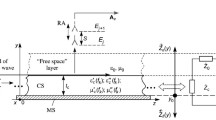Abstract
A methodology of the selection of the initial materials, architecture and synthesis of heterostructures based on domestic materials and technologies as applied to specific types of microwave components needs to be developed. As the nomenclature expands, the requirements on energy consumption, overall dimensions and weight, frequency range, noise, values of working temperatures, and other characteristics of microwave components have significantly increased. Specific examples of power amplifiers for various applications (wireless communication systems and location systems) are considered. It is shown that in order to implement such developments, it is necessary to apply modern methods of multilevel computer modeling using various methods of optimization and widely use the tested technical solutions. The final result of this development is the creation of a set of basic physical models of the heterostructures, including those based on the solution of optimized problems by choosing the initial material, substrate material, layer composition, their sequences, layer thicknesses, impurity contents, and their distribution by the layer thickness. All this makes it possible to form an acceptable level of mechanical stresses and high values of the electrophysical characteristics in the heterostructure. The initial data set in the form of a library of basic models of the heterostructures will make it possible to significantly accelerate the development of various microwave components and optoelectronic components in the system of instrument and technological design and improve the characteristics of the devices and economic rates.
Similar content being viewed by others
References
Nemudrov, V., Borisov, K., Zavalin, Yu., Korneev, I., Malyshev, I., and Shiller, V., The systems on the chip and the systems in the case, Elektron. NTB, 2014, no. 1, pp. 144–150.
Dmitriev, V.F. and Osipov, A.M., Modeling of microwave transistors by extrapolation of S-parameters, Vestn. Novgor. Univ., 2004, no. 26, pp. 74–77.
Radchenko, D. and Sbitnev, K., Modeling of microwave transistors based on epitaxial heterostructure (HEMT) using Synopsys Sentaurus TKAD. http://www.russianelectronics. ru/engineer-r/review/2327/doc/48316/.
Torhov, N.A., Babak, L.I., Bozhkov, V.G., Razzhuvalov, A.N., and Sal'nikov, A.S., Physical modeling of GaN/AlGaNHEMT nanoheterostructures and highpower microwave transistors using the Synopsys package, Dokl. TUSURa, 2012, no. 2 (26), pp. 145–151.
Kishchinskij, A., Broadband transistor amplifiers of the microwave range: alternation of generations, Elektron. NTB, 2010, no. 2, pp. 60–67.
Yurkov, R., Components of NEC electronics for wireless communication based on silicon-germanium technology, Kompon. Tekhnol, 2006, no. 11, pp. 18–20.
Arendarenko, A.A., Oreshkin, B.A., Sveshnikov, Yu.N., and Tsyplenkov, I.N., Trends in the development of the epitaxial nitride compounds technology, Mod. Electron. Mater., 2016, vol. 2, no. 2, pp. 33–40. doi 10.1016/j.moem.2016.10.001
Alecksandrov, R., Monolithic microwave integrated circuits: inside view, Kompon. Tekhnol., 2005, no. 9, pp. 174–182.
Vector Optimization. http://sov.opredelim.com/docs/137600/index-1761.html.
Majskaya, V., High-frequency semiconductor devices. Not silicon and gallium arsenide unified, Elektron. NTB, 2004, no. 8, pp. 16–21.
Abgaryan, K.K., Application of optimization methods for modelling of semiconductor film nanosystems, Tr. Inst. Sist. Anal. RAN, Dinam. Neodn. Syst., 2010, vol. 53, no. 3, pp. 6–9.
Abgaryan, K.K. and Reviznikov, D.L., Numerical simulation of the charge carrier distribution in nanoscale semiconductor heterostructures with allowance for polarization effects, Comput. Math. Math. Phys., 2016, vol. 56, no. 1, pp. 161–172.
Abgaryan, K.K., Mutigullin, I.V., and Reviznikov, D.L., Computational model of 2DEG mobility in AlGaN/GaN heterostructures, Phys. Status Solidi C, 2015, vol. 12, nos. 4-5, pp. 460–465. doi 10.1002/pssc.201400200
Abgaryan, K.K., Mutigullin, I.V., and Reviznikov, D.L., Theoretical investigation of 2DEG concentration and mobility in the AlGaN/GaN heterostructures with various Al concentrations, Phys. Status Solidi C, 2015, vol. 12, no. 12, pp. 1376–1382. doi 10.1002/pssc.201510159
Fedorov, Yu.V. and Mikhaylovich, S.V., Nitride HEMTs vs arsenides: The ultimate battle?, Mod. Electron. Mater., 2016, vol. 2, no. 1, pp. 1–6. doi 10.1016/j.moem.2016.08.006
Vinokurov, D.A., Kapitonov, V.A., Lyutetskiy, A.V., Nikolaev, D.N., Pikhtin, N.A., Slipchenko, S.O., Stankevich, A.L., Shamakhov, V.V., Vavilova, L.S., and Tarasov, I.S., 850 nm diode lasers based on AlGaAsP/GaAs heterostructures, Semiconductors, 2012, vol. 46, no. 10, pp. 1321–1326.
Vinokurov, D.A., Lyutetskiy, A.V., Nikolaev, D.N., Shamakhov, V.V., Bakhvalov, K.V., Vasilyeva, V.V., Vavilova, L.S., Rastegaeva, M.G., and Tarasov, I.S., 850 nm diode lasers with various compensation techniques of internal mechanical stress in AlGaAs(P)/GaAs heterostructure, Semiconductors, 2013, vol. 47, no. 8, pp. 1075–1078.
Marmalyuk, A.A., Ladugin, M.A., Yarotskaya, I.V., Panarin, V.A., and Mikaelyan, G.T., Laser diode bars based on strain-compensated AlGaPAs/GaAs heterostructures, Quantum Electron., 2012, vol. 42, no. 1, pp. 15–17. doi 10.1070/QE2012v042n01ABEH014737
Zhu, D. and Humphreys, C.J., Low-cost high-efficiency GaN LED on large-area Si substrate, in Proceedings of the CS MANTECH Conference, New Orleans, LA, 2013, pp. 269–272.
Author information
Authors and Affiliations
Corresponding author
Additional information
Original Russian Text © K.K. Abgaryan, V.A. Kharchenko, 2016, published in Izvestiya Vysshikh Uchebnykh Zavedenii, Materialy Elektronnoi Tekhniki, 2016, Vol. 19, No. 1, pp. 47–53.
Rights and permissions
About this article
Cite this article
Abgaryan, K.K., Kharchenko, V.A. The Standard Model of the Heterostructure for Microwave Devices. Russ Microelectron 46, 564–570 (2017). https://doi.org/10.1134/S1063739717080029
Published:
Issue Date:
DOI: https://doi.org/10.1134/S1063739717080029




